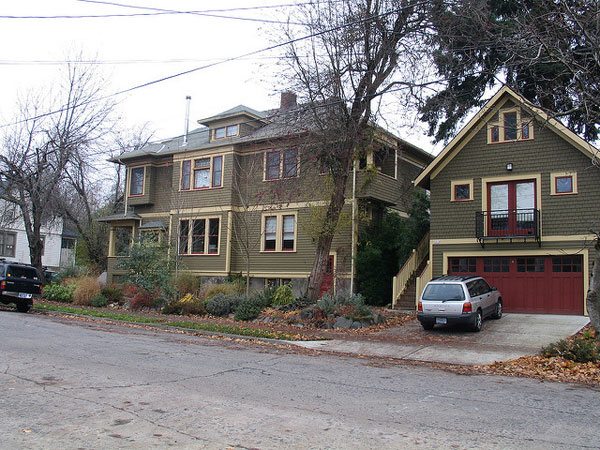
April 27, 2018; Next City
In hot-market cities, in-law housing—also known as “granny flats” and officially often designated as “accessory dwelling units,” or ADUs—is making a comeback. Common during World War II when migration to cities outpaced housing development, this form of housing has long been discouraged by zoning ordinances. But that is changing, notes Jared Brey in Next City, as cities acknowledge that one of the most effective ways to increase the housing supply is to encourage add-on units to existing lots.
The San Francisco Bay Area has one of the hottest housing markets in the country. In San Francisco proper, the median home price is now $1.6 million, twice as much as in 2013. For the Bay Area as a whole, the cost is lower but, at $820,000, still nobody’s bargain; according to the New York Times, $820,000 requires a household income of over $171,000—and that assumes you have $164,000 that you can apply to the down-payment.
It is thus not surprising that many Bay Area cities are seeking to increase the housing supply by encouraging in-law units. For example, “San Francisco passed a local ordinance in 2014 that allowed owners to legalize one accessory unit per residential lot,” notes Brey. San Francisco has spawned many Bay Area imitators, including most cities in neighboring San Mateo County.
In 2016, the state of California also followed San Francisco’s lead and passed three laws to facilitate in-law unit production. These laws did three things: 1) made it easier and cheaper to build a second unit, 2) made it easier for homeowners to convert an illegal unit into a legal one; and 3) sought to “ease or eliminate the off-street parking requirements and often-enormous utility-hookup fees that homeowners face when they create a second dwelling.”
According to the Terner Center for Housing Innovation at the University of California, Berkeley, in Los Angeles, the city had 1,980 applications in 2017 for in-law units. Before 2017, the city did not even track these, except for new construction, which was below 100 units. In San Francisco, the number of applications has skyrocketed from 41 in 2015 to 593 for the first three quarters of 2017.
Sign up for our free newsletters
Subscribe to NPQ's newsletters to have our top stories delivered directly to your inbox.
By signing up, you agree to our privacy policy and terms of use, and to receive messages from NPQ and our partners.
“This year,” notes Brey, “San Francisco earned a National Planning Achievement Award for its efforts.” In its award announcement, the American Planning Association noted that in-law units in San Francisco “cost less than $150,000 to build compared to $500,000 for new development.”
According to Gina Simi, communications manager for the San Francisco Planning Department, there are currently around 1,200 in-law units in the construction pipeline. Additionally, 685 permits have been submitted to legalize pre-existing in-law units, with 166 of these already approved. As Brey explains, “In order to become legal, accessory units have to meet all the standards of the Building Code, but not some zoning requirements that apply to other new residential construction, like standards related to parking, open space, and density.”
Brey notes that some obstacles remain in place. For instance, Todd David, executive director of the San Francisco Housing Action Coalition, contends that if construction were “really by right,” San Francisco could build as many as 10,000 new in-law units in three years.
Jennifer Fieber, political campaign director for the San Francisco Tenants Union, notes that in-law unit construction is not always simple and can sometimes disrupt existing housing. For example, Fieber mentions that “some long-term tenants are being pushed out due to construction work to add units to existing multifamily buildings or bring old units into compliance.”
“I think [in-law units] are a great idea, because they’re generally going to be smaller, they’re in unused spaces, and we’re running out of space to build new buildings,” Fieber says. “I totally support it, but they just need to be careful.”
Outside of California, the in-law unit idea is spreading too. For example, in its “Fourth Regional Plan” for the New York City metro area, the Regional Plan Association recommended that municipalities revive zoning laws to encourage in-law units. Brey notes that the plan writers indicate that, “If just 10 percent of single- and two-family homes in the region built an accessory unit…the region would add 300,000 new homes to its supply.”—Steve Dubb












